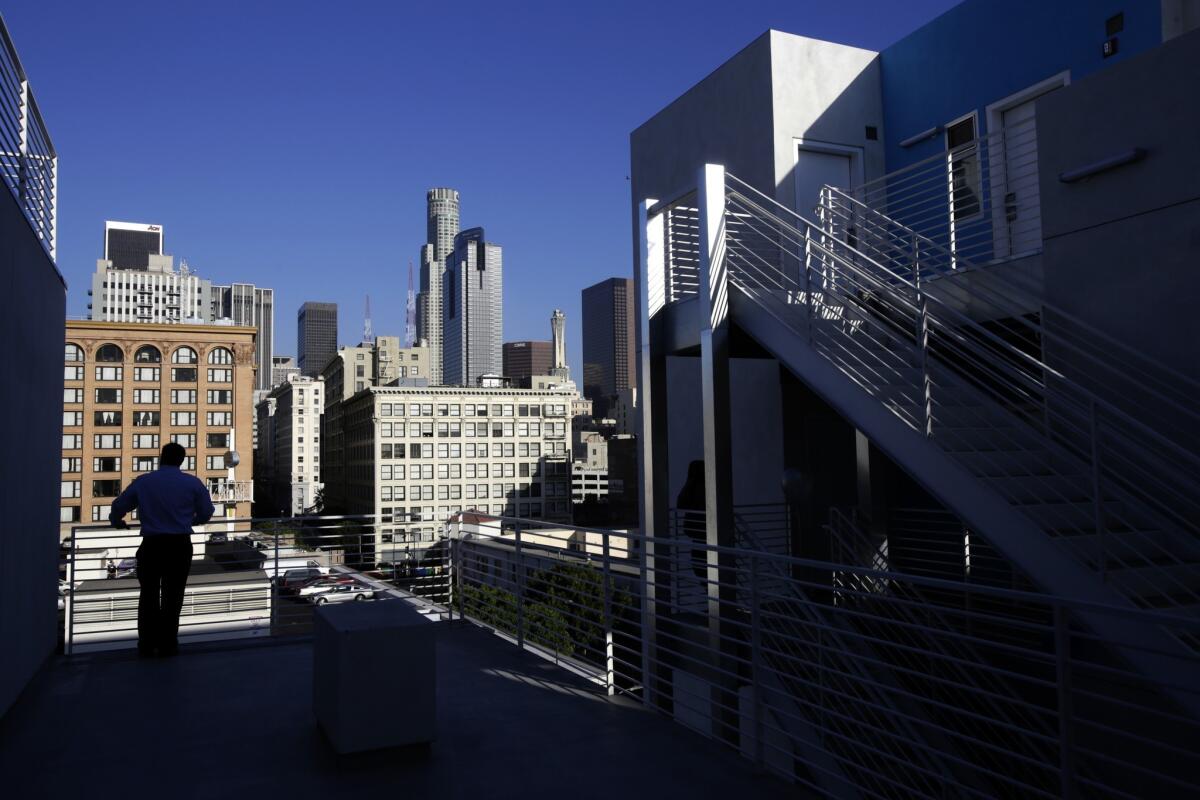Health agency moving to skid row to aid homeless

- Share via
A Los Angeles County health agency is moving its headquarters and medical clinic into the heart of skid row in what experts said could become a national model for curbing homelessness.
The $18-million Housing for Health program aims to get 10,000 of the county’s sickest, most vulnerable people off the streets and into permanent housing.
In a departure from previous efforts, the county is spending health funds — $14 million — on homeless housing in the belief that getting a place to live is the best medicine for homeless people with medical and mental health disorders. The Conrad Hilton Foundation contributed $4 million.
Officials say that the program is committed to transforming skid row, the epicenter of the county’s homeless problem, one of the worst in the nation.
“No matter how many people get off the street, the real measure is, is skid row improving?” Housing for Health Director Marc Trotz said. “That’s the mantra.”
The offices and clinic are moving this week into the ground floor of the $40-million Star Apartments, a striking, 100-unit complex for homeless people made of prefabricated modules, stacked like children’s blocks at Maple Avenue and 6th Street.
The Skid Row Housing Trust building began accepting tenants in November, but delayed its official opening until Wednesday to give residents time to settle in.
Resident Bill Fisher, 61, a former ironworker trade unionist, called the Star apartments “mind-boggling” and a welcome refuge after heart troubles and the death of his life partner landed him in the streets.
“If somebody had told me 10 years ago I’d lose everything and end up homeless I’d have said you’re nuts,” said Fisher, who decorated his studio apartment with art projects, including antique sheet music, his guitar collection and an orchid suspended from a palm frond.
Housing for Health’s approach is based on studies showing that housing not only heals but also saves money. Emergency room visits and hospitalizations of homeless people dropped 77 % in the year after they were housed at a savings to the county of $32,000 a person, a 2013 study by the Economic Roundtable found.
Moving from a downtown office tower to skid row underscores the program’s mission of making a noticeable difference in the streets, Trotz said.
Although the housing is not restricted to skid row residents, 60% of the 50-block district’s thousands of homeless people have mental health disorders, a history of addiction, or both, officials said.
Many carom from skid row to Los Angeles County-USC Medical Center and jail, taxing county resources.
Rather than concentrating homeless people in large complexes in downtown Los Angeles, Housing for Health is scattering them in duplexes, apartment buildings and houses throughout the county, including the San Fernando Valley and Culver City. Each resident receives intensive counseling, case management and treatment to keep them in housing.
“The investment by the county is a national example of what can be done,” said Dr. Joshua Bamberger, associate professor of family and community medicine at UC San Francisco, who is a former colleague of Trotz. “Nothing’s going on as exciting as what’s going on in L.A.”
Retired UCLA law professor Gary Blasi, a homelessness expert who has been critical of previous city and county policy, praised Housing for Health, but said other government agencies need to follow suit.
“Other departments, and the Board of Supervisors — with notable exceptions — have been much slower to respond to the fact that the same is true of mental health care and addiction treatment … and that providing supportive or therapeutic housing is not only the humane and civilized response, but also the most cost-effective,” Blasi said in an email.
Longtime homeless advocate Mollie Lowery applauded the program’s vision but said that without more affordable and homeless housing construction, it would be a partial solution at best.
“There aren’t enough apartments to go around for regular folks,” she said.
gale.holland@latimes.com
Twitter: @geholland
More to Read
Sign up for Essential California
The most important California stories and recommendations in your inbox every morning.
You may occasionally receive promotional content from the Los Angeles Times.














